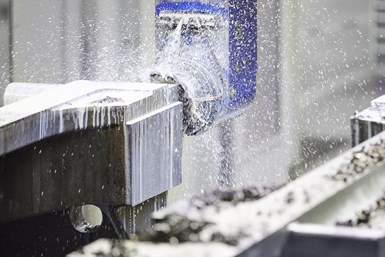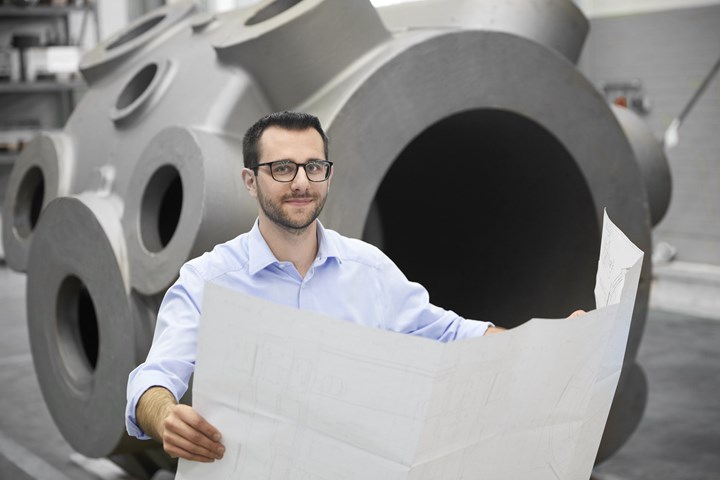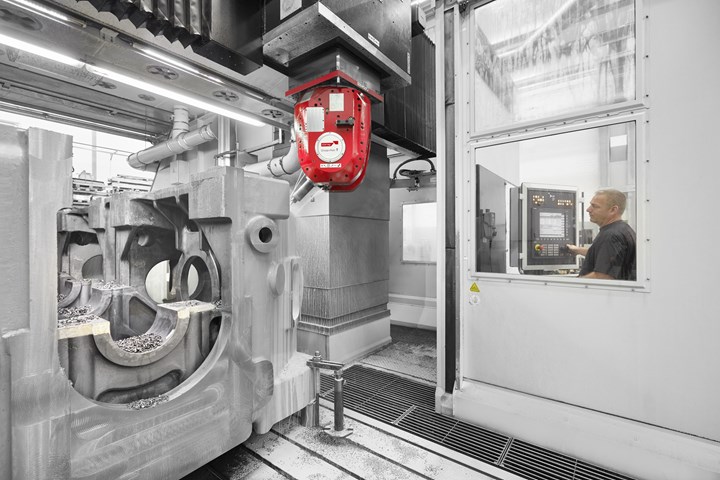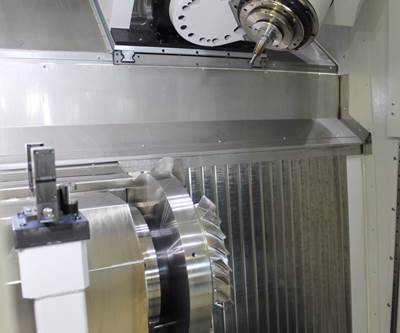Portal Milling Machine Provides Years of Smooth Operation
Neuman & Esser uses their eight-year-old Droop+Rein from Starrag as a “workhorse” for complete machining.
Share






The strength of the Starrag Droop+Rein T portal machining center lies in complete machining, which is performed with or without coolant depending on the workpiece. Minimum-quantity lubrication, however, is not required owing to the high-strength materials. All photos courtesy of Starrag/Ralf Baumgarten.
Large machine tools are a large investment. Fortunately for Neuman & Esser (NEA), the benefits it gained from Starrag’s Droop+Rein proved equally sizable.
“The Droop+Rein is one of our best workhorses in the stable,” says Alexander Peters, NEA managing partner. “We are very satisfied with this machine tool, its performance and the service provided by the manufacturer.”
He is talking about a Starrag portal machining center with adjustable crossbeam and movable clamping table. The Droop+Rein T 30 40 DT R50 C is currently the largest machine tool investment in the history of the NEA Group, and it has proven itself in the machining of demanding components such as those for piston compressors in compressor systems that handle technical process gases as well as for pendulum-mill housings in crushing technology.
“We have had the portal machining center in continuous operation since 2011,” says Simon Prell, NEA manager of mechanical production. “We mainly use it to machine crankcases and spacers as part of three-shift operation. These parts stop gas from escaping the cylinder into the crankcase and oil from moving into the cylinder from there.”

Simon Prell says that the unusually high permanent accuracy of the portal milling machine benefits his company in applications such as retrofitting work.
NEA also uses the machine tool to produce cast components for pulverizers. This usually entails complete machining, which can be performed with or without coolant, depending on the workpiece. Minimum-quantity lubrication, however, is not required owing to the high-strength materials such as iron and steel alloys with a high nickel or chromium content.
According to the company, the Droop+Rein was well received, even during the commissioning phase eight years ago. In fact, the company says it was one of the smoothest introductions it has ever experienced, despite involving switching to a completely new form of machining.
From Horizontal to Portal
In 2011, NEA was machining crankcases on a horizontal boring mill. One of the main problems with this method was long periods of non-productive time due to time-consuming clamping processes. By contrast, only a single clamping process is necessary on its portal machining center, greatly reducing machining times on its extremely heavy workpieces. The crankcases can also be machined in their operating position. According to Mr. Prell, a major benefit of the portal machine is that the different machining heads can be optimally positioned and aligned.
According to production manager Achim Hoch, “When machining crankcases on a horizontal boring mill, we always had to reclamp them several times to orient the part surface perpendicular to spindle access. However, each additional reclamping process led to faults. And finally, after an informative visit to the Munich BMW tool shop, which had several Droop+Rein portal machining centers, we decided to invest in this machine.”
The portal machining center features two tables, each measuring 118.1 by 157.4 inches. The X-axis travel path measures 196.9 inches per table and 413.4 inches coupled, while the Y- and Z-axis travels measure 177.2 and 68.9 inches, respectively. Other features include 137.8 inches of passage width between columns and a 137.8-inch clearance height between the table and moving crosshead. A Siemens Sinumerik C 840D controls the machine, and tool change is provided by an automatic changing system with a chain magazine and 80 storage spaces.
Technician Jürgen Seek has been satisfied with this investment. “Thanks to the use of ceramic tools, we can largely manage without coolant,” he says about the dry machining process.
Mr. Seek says he is glad he no longer has to reclamp the workpiece multiple times. The gigantic component is machined in three steps: After milling the lower, laser-probed surface, he rotates the housing by 180 degrees to allow the bottom to be machined. He then turns the ductile cast iron GGG-40 component back to its initial position for complete machining.

Technician Jürgen Seek says that the portal milling machine’s capabilities surpass what Neuman & Esser is currently using it for.
“The machine can do much more,” he says. “We've never been able to really wear it out — not even when even test machining titanium.”
Mr. Seek says his most difficult job so far has been retrofitting a 30-ton crankcase. “The crankcase, which was not assembled, was very unstable and difficult to clamp. But we still had to machine it exactly to hundredths of an inch.”
Large Investment, Large Benefits
NEA has not regretted its decision to purchase the Droop+Rein. The investment has paid off because, depending on the workpiece size, the machining time has fallen by an average of 30 to 40%, and accuracy has doubled even in critical areas. Tolerance in the bearing race is now only 20 microns instead of 40.
Starrag checks the portal machine’s geometry completely every two years and realigns it if necessary. “So far, the realignment has been to such a small degree that we could actually go without it,” Mr. Prell says.
To ensure that even demanding jobs are performed with precision, NEA measures the components using complex 2D and 3D laser technology.

Mr. Seek says he is glad he no longer has to reclamp the workpiece multiple times during the complete machining of a 50-ton crankcase made of ductile cast iron (GGG-40).
In eight years of continuous operation, there has not been a single failure, with Starrag only having to replace the ball spindles once. According to Mr. Prell, this replacement is not unusual with operations for which the moving crosshead is often moved.
While Mr. Prell and his team have rarely needed to consult with Starrag service technicians, they have always been satisfied with their high-quality work. “We have a permanent contact at Starrag who knows us well,” Mr. Prell says. “There is clearly a good communicative relationship between our employees and Starrag service.”
But can satisfaction with the Droop+Rein T series portal milling machine be substantiated and summarized? “We prioritize quality, and the portal milling machine is excellent,” Mr. Hock says.
“The machine does exactly what we hoped it would,” Mr. Prell adds. “So far we haven’t exceeded the limits of its abilities.”
Related Content
Inside the Premium Machine Shop Making Fasteners
AMPG can’t help but take risks — its management doesn’t know how to run machines. But these risks have enabled it to become a runaway success in its market.
Read MoreBallbar Testing Benefits Low-Volume Manufacturing
Thanks to ballbar testing with a Renishaw QC20-W, the Autodesk Technology Centers now have more confidence in their machine tools.
Read MoreCNC Machine Shop Honored for Automation, Machine Monitoring
From cobots to machine monitoring, this Top Shop honoree shows that machining technology is about more than the machine tool.
Read More5 Tips for Running a Profitable Aerospace Shop
Aerospace machining is a demanding and competitive sector of manufacturing, but this shop demonstrates five ways to find aerospace success.
Read MoreRead Next
Starrag Tech Days Highlight Turbine Technology Applications
A visit to Starrag headquarters in Roschacherberg, Switzerland during the company's 2018 technology days revealed new equipment, tools, technologies and machining strategies for turbine manufacturing.
Read MoreOptimized Milling Strategy for Five-Axis Titanium Blisk Machining
A new finishing strategy using specially designed barrel cutters is said to reduce five-axis titanium blisk machining times by 50 percent.
Read More5 Rules of Thumb for Buying CNC Machine Tools
Use these tips to carefully plan your machine tool purchases and to avoid regretting your decision later.
Read More





















.jpg;maxWidth=300;quality=90)





.JPG;maxWidth=400;quality=70)


